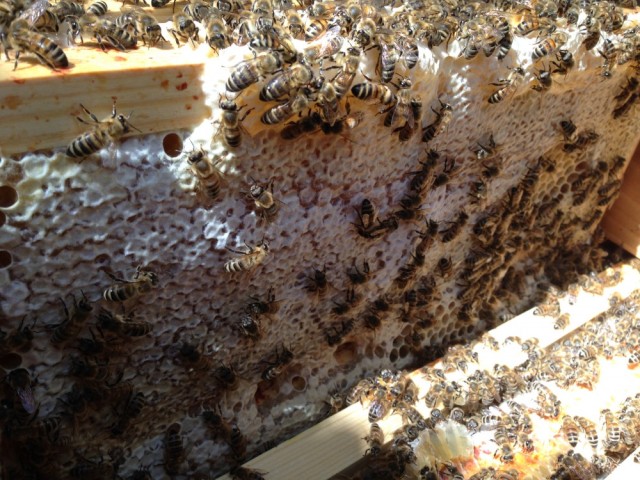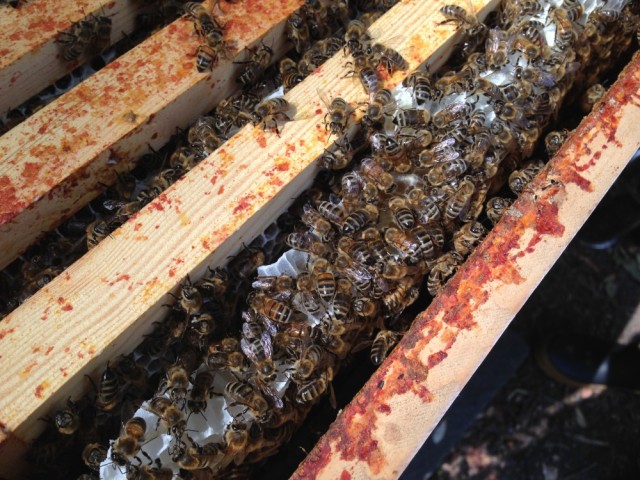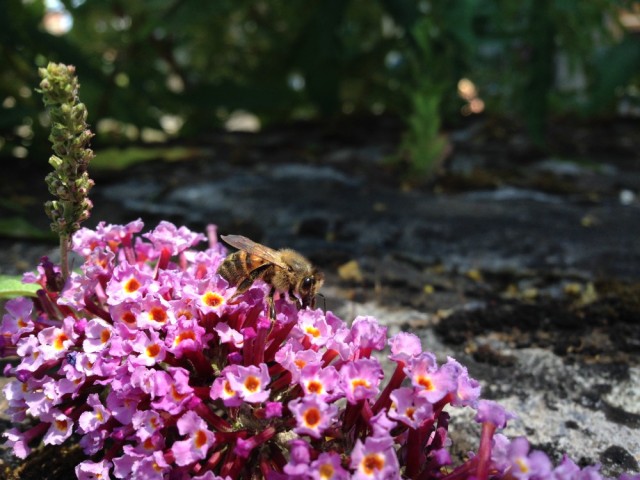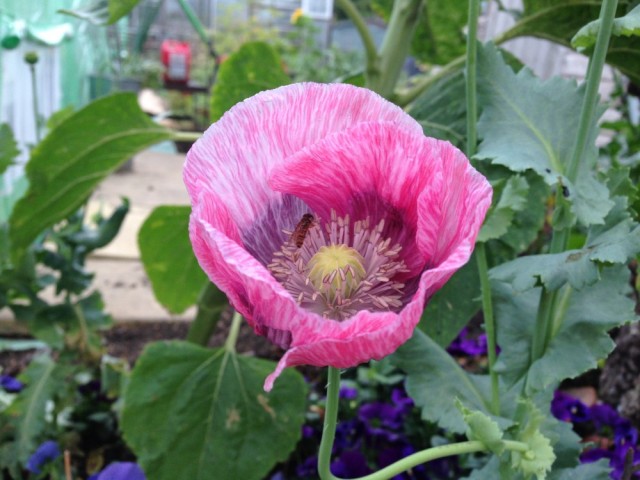It is always satisfying to solve a mystery. Even when you turn out to be the culprit.
You may recall me mentioning that Queen Andromeda has been missing in action since I combined her colony with Queen Cassiopeia’s on 6th June, as poor Cassiopeia had turned out to be a drone layer. Two test frames of eggs/larvae kindly donated by Tom had resulted in no queen cells being produced – usually an indication that a satisfactory queen is already present. Yet I could find no eggs or uncapped larvae in the brood box and could not find Queen Andromeda, who had previously been a star layer.
Well, yesterday I looked in my super properly. At first it seemed to be bursting with incredibly heavy capped honey. But then – a tiny bit of worker brood on one of the frames. Could it be?… and there, climbing up a super frame with an egg emerging cheekily from her abdomen, was the elusive, much looked-for, Queen Andromeda. A face-palm moment. She has now been moved down into her rightful home, her two brood boxes.
This colony at the allotment has given me no end of trouble this year but I have learnt a few things from it:
- Trust the test-frame. If they don’t make queen cells from a test-frame you put in containing eggs and larvae, you can be pretty certain they already have a queen they’re happy with, even if you can’t find any evidence of her.
- If something goes wrong, it’s probably your fault! Beekeeper error seems to cause the majority of queen problems and indeed most beekeeping problems in general.
- Inspect supers more closely. I have been avoiding doing this because the bees are so tightly packed in there it’s hard to take frames out without rolling the bees and squashing them, but smoke would help with that. We have discovered a queen cell in the top of Melissa’s two supers this year!
Here’s another amusing thing we found in Melissa’s super yesterday.
It’s a wall of comb. They have done away with the bottom bee space and joined the top and bottom frames in the two supers together. Such naughty bees.
Oh and here is another brilliant example of beekeeper error. This is what happens when you leave a super one frame short in the hottest week of the year. The bees fill the space in for you with a perfect comb which makes it impossible to take the super off to inspect the brood box. We will have to put bee escapes in next weekend and then harvest some cut comb the next day once all the bees have left.
Meeting this sweet little honey bee was a high point of my Friday lunch break. I was walking along by some ruined roman walls, a busy walkway used by tourists and office workers. Stopping to look at pretty wildflowers growing along the walls, I noticed a honey bee crawling on the pavement. I touched her but she didn’t fly off. This concerned me as she seemed sluggish and so perhaps likely to get stepped on. I put my hand down to her and she climbed on. Cupping her gently in my hands, I carried her to this buddleia flower, as she seemed in need of sustenance.
To be honest, I think she probably died soon after I left her. She seemed barely able to move. But I was comforted that here was somewhere fragrant and peaceful for her to pass away. Better for this tired summer worker to die surrounded by the enveloping heady scent of nectar – her life’s work – than to be trodden underfoot by someone’s unseeing shoe.
In honour of her memory, and in honour of all her hard-working nectar and pollen carrying relatives, here is a pretty poppy.






I sometimes place bees that look exhausted on the concrete onto a flower, perhaps the best background to pass their last moments of life rather than the artificial deadness of human civilisation.
LikeLike
That is a kind thing to do. Honey bees can taste through their feet and I’m sure flowers taste nicer than concrete. A more fitting ending too.
LikeLiked by 2 people
Aww poor bees 😦 Dear little souls.
LikeLiked by 1 person
They are such lovely creatures.
LikeLike
One of the advantages of the National hive is that, being square, you can align supers at right angles to each other. This reduces their tendency to join combs that are aligned vertically.
LikeLike
Thanks Chris, I hadn’t thought of that and have never seen anyone do it! Good tip to know.
LikeLike
We don’t have any buddleia flowers at all yet. At least we have had a few warm, sunny days.
LikeLike
We have had a good run of a sunny, hot fortnight, so buddleia has been out for a while now. The blackberry flowers are almost over.
LikeLike
No blackberry flowers either, I don’t think. Oh well – we have that to look forward to!
LikeLike
Yes – you really are behind!
LikeLike
So good to get the mystery solved, you really have adventuring bees but the points you mention have been noted. Amelia
LikeLike
Thanks Amelia, a big sigh of relief and hoping all is well next weekend!
LikeLike
I always feel bad for those bees on the pavement, so I know what you mean. They work hard all their lives and better to pass in a nice way than being squished. Keeper errors. I am shocked. You know more about bees that anyone so I just can’t see you making an error.
LikeLike
Thanks Donna but there are many, many people who know more about bees than me! Every year new things happen in my hives and I realise just how much I have yet to learn.
LikeLike
So glad you found Queen A! Nice ending to a perplexing problem. I find myself looking closely at the flowers everywhere I go this year, looking to see if any bees are visiting. I’ll have to start checking the pavement as well, perhaps.
LikeLike
Thanks Erik! I know what you mean about looking for bees on all the flowers. The big bumblebees seem to be found crawling on the pavement more often, they get tired and then can be carried to a flower to regain their energy.
LikeLike
Ah, she probably wanted to see the world a bit before being too tied down by her new responsibilities. And, yes, bees do not like a vacuum and have many creative ways of filling it. If only they would do what they are told!
LikeLiked by 1 person
I see, perhaps Andromeda was having a little holiday from egg-laying up there in the land of honey. A good trick to play on me!
LikeLiked by 1 person
Ah yes, that far away but oh so close land where there is all the honey you can eat and no worker daughters to harass you….
LikeLike
He he!
LikeLike
Thank you for passing your knowledge along about the test frame. Great to know a way to figure out if they have a queen they’re happy with or not.
LikeLike
That’s ok. If nothing happens with the first test frame in you can put another in to double-check.
LikeLike
I think looking in the Super would have been my first though – but maybe that’s just because I almost ALWAYS expect the bees to be up to some sort of mischief! 🙂
Al.
LikeLike
He he! Next time I shall assume the naughtiest possible option and go from there 🙂
LikeLiked by 1 person